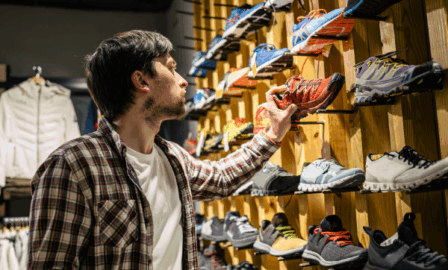Improving Customer Engagement in Apparel
As customers are expecting a unified shopping experience across all channels, the push for retailers to engage in the digital age is vital. Nothing proved this to be truer than the 2020 pandemic, which forced retailers to focus on optimizing their omnichannel capabilities to enhance a customer’s shopping experience to drive sales, as foot traffic in stores was almost nonexistent. The demand to meet customers where they are in terms of convenience and need is the main driver for the changing shopping dynamic. For retailers, this means it’s important to understand the evolving customer journey map and its role in improving customer engagement in apparel. Implementing innovative solutions and processes that encourage customer engagement and loyalty is key to staying competitive in this rapidly changing market.
Customer Engagement and Loyalty
Why is shopper loyalty so important? In the apparel segment of retail, customer engagement drives loyalty, so understanding why shoppers are loyal and what creates shopper-retail relationships is of the utmost importance. Customer loyalty allows businesses to grow by establishing trustworthy relationships with shoppers. These relationships yield repeat customers, which can be a cost advantage, as most businesses report it costs 5x as much to attract a new customer as it does to retain a current one.
Additionally, your shoppers won’t just keep coming back themselves – as engaged and trusted customers, they’ll recommend your products to friends and family, ultimately serving as a loyal brand promoter. However, customer loyalty is becoming harder to achieve, as shoppers now have an abundance of options to choose from when shopping in the highly competitive apparel market. To combat the challenge of retaining shoppers, apparel retailers should be focusing on a multi-faceted strategy to improve engagement and loyalty.
Initiatives Driving Customer Engagement and Loyalty
Loyalty Programs
In order to promote customer loyalty, retailers are using loyalty programs as a key focal point of their customer retention strategy. As many as 84% of shoppers say they are more apt to stick with a brand that offers a loyalty program, and 66% of customers say the ability to earn rewards changes their spending behavior. With loyalty programs, retailers can optimize shopper engagement by understanding buying habits, customizing promotions, and providing purchase options. Retailers not only need to ensure that they have a strong loyalty program, but that it’s ubiquitous across channels – benefits and rewards should be available and redeemable regardless of how the customer is shopping.
Community Service Initiatives
Retailers can also build engagement and loyalty through philanthropic-focused initiatives. A product mission that resonates with the customer’s mission will facilitate purchasing decisions that are beneficial for the business and the community. As customers recognize your company’s commitment to community service initiatives, engagement and loyalty will increase as shoppers will have a stronger sense of identity to the brand.
For example, Polo Ralph Lauren announced far-reaching plans to act in the name of racial equity following the 2020 Black Lives Matter Movement, including pledging $2 million to a dozen historically Black colleges and universities (HBCUs) and offering an exclusive line highlighting Morehouse and Spelman in December 2021.These initiatives are important for customer engagement because shoppers are seeing the brands they support also support initiatives they care about. One report shows that 94% of shoppers believe companies need to do more than just earn profits – customers expect retailers to support social causes in their communities and in the world at large. They value companies that are purpose-driven, so giving back to the community can be a huge factor in customer engagement and behavior.
Interactive Online Shopping
Since the popularization of digital shopping, online shoppers have been sacrificing the ability to try on and feel the clothes, which is evident through online stores’ conversion rates. However, brick-and-mortar stores can get up to a 67% conversion level when their shoppers go into dressing rooms. Once a customer receives a chance to try on retail items, they feel much more inclined to buy something. With these insights, retailers need to focus on creating experiences that allow customers to visualize themselves in the apparel virtually. Most online shops provide buyers with photos and descriptions of the products. However, online shoppers want to experience and interact with products to ensure that they will receive exactly what they ordered.
For example, Gap has implemented technology that allows customers to choose a certain body type to model the clothes. Offering these options will accommodate more shoppers and allow them to visualize the clothes on a body type similar to themselves. Augmented and virtual reality technology have each been used to create this more immersive experience online. Creating virtual features that give consumers an in-person touch or allows them to better visualize themselves in the products can boost customer engagement and potentially persuade shoppers to hit that checkout button.
The Brick-and-Mortar Experience
As online shopping develops, it’s important for retailers to bridge the gap between channels and enhance their brick-and-mortar experience with their digital technology – creating better personalization and experiential purchasing in the process. For example, Lush’s app-first stores uses their app as the primary source of product information and in-store interactivity. The new Lush store is completely packaging free, and offers information including ingredients, properties, and even visuals to show how products will dissolve in your bathtub when scanned. This type of interactive and personalized brick-and-mortar experience is driving customer engagement and interest, as shoppers feel like their in-person shopping experience can be as simple and convenient as their online purchases. While this example is in the cosmetics space, it can be translated to apparel where product materials, sourcing information, and sustainability can all be supplemented by a mobile app.
Learn more about our retail consulting services
Looking Ahead
Online shoppers are expecting more from apparel companies than just a click-to-cart shopping experience. They want to feel that their wants and needs are being listened to, and they appreciate when retailers demonstrate a commitment to the values and ideals that customers also care about. From establishing loyalty programs, to partnering with non-profits to reach your philanthropic goals, to creating a more personalized shopping experience both in-person and online, retailers can find ways to effectively build and retain customer engagement and trust.
Depending on your business goals, increasing shopper engagement looks different to everyone; however, understanding what apparel-driven solutions work for your business is key to remaining competitive in our evolving retail world.
Subscribe to Clarkston's Insights
Contributions from Cory Jackson and Leah Harding



